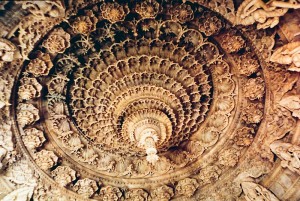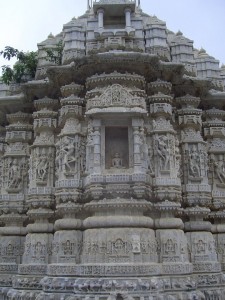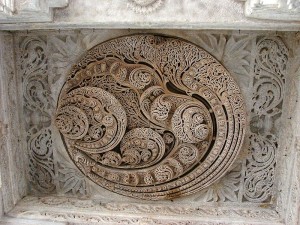
The Dilwara temples of India are located about 2½ kilometers from Mount Abu, Rajasthan’s only hill station, Its rank among the popular tourist attractions in Rajasthan. The five temples of Dilwara – Vimal Vasahi, Luna Vasahi, Pithalhar, Khartar Vasahi, and Mahavir Swami – have their own uniqueness to speak of. These Jain temples were built by Vastapul Tejpal, Jain laymen between the 11th and 13th centuries AD and are world-famous for their stunning use of marble. some experts also consider it architecturally superior to the Taj Mahal.
The marble temples have an opulent entranceway, the simplicity in architecture reflecting Jain values like honesty and frugality. The temples are in the midst of a range of forested hills. A high wall shrouds the temple complex. The door opens on to a blend of irresistible beauty and elegance. The temples are surrounded with mango trees and wooded hills and a high wall that shrouds the entire temple complex.The door opens on to a blend of irresistible beauty and elegance. The temples are surrounded with mango trees and wooded hills and a high wall that shrouds the entire temple complex. Dilwara Temple forms a famous pilgrimage of the followers of Jainism. The striking use of marble, in the construction of this temple, is truly worth-admiring.
History :
 Mount Abu located in the southwest part of Rajasthan is a part of the Aravalli Mountain Ranges and is separated from the Aravalli by a narrow valley and Guru Shikhar is the highest point at the northern end. These Jain temples were built by Vastapul Tejpal, a Jain layman between the 11th and 13th centuries AD. The five legendary marble temples of Dilwara are a sacred pilgrimage place of the Jains. Some consider them to be one of the most beautiful Jain pilgrimage sites in the world. The five shrines that are dedicated to Lord Adinath, Lord Rishabhdeo, Lord Neminath, Lord Mahavir Swami and Lord Parshvanath respectively. All of its ceilings, doorways, pillars and panels has minutely carved ornamental details which show its architectural uniqueness. The Dilwara temples are dedicated to the Jain Tirthankaras and served as storehouses of illustrated manuscripts and treatises. The temples at Mount Abu were constructed between 800 AD and 1200 AD. Vimala Shah, Vastu Pala and Teja Pala contributed a lot toward the development of Jain art and architecture.
Mount Abu located in the southwest part of Rajasthan is a part of the Aravalli Mountain Ranges and is separated from the Aravalli by a narrow valley and Guru Shikhar is the highest point at the northern end. These Jain temples were built by Vastapul Tejpal, a Jain layman between the 11th and 13th centuries AD. The five legendary marble temples of Dilwara are a sacred pilgrimage place of the Jains. Some consider them to be one of the most beautiful Jain pilgrimage sites in the world. The five shrines that are dedicated to Lord Adinath, Lord Rishabhdeo, Lord Neminath, Lord Mahavir Swami and Lord Parshvanath respectively. All of its ceilings, doorways, pillars and panels has minutely carved ornamental details which show its architectural uniqueness. The Dilwara temples are dedicated to the Jain Tirthankaras and served as storehouses of illustrated manuscripts and treatises. The temples at Mount Abu were constructed between 800 AD and 1200 AD. Vimala Shah, Vastu Pala and Teja Pala contributed a lot toward the development of Jain art and architecture.
Five Unique Temples of Dilwara:
There are five temples in all, each with its own unique identity. Each is named after the small village in which it is located.
1. Vimal Vasahi Temple:
 The oldest among the five temples of Dilwara, this exquisite piece of architecture was constructed by Vimal Shah, completed in AD 1032. This temple is the oldest of all and dedicated to Shri Adinath Ji – The first jain trithankar, the temple has an open courtyard surrounded by corridors all beautifully decorated with marble carved stones. The plan of the temple resembles that of Kashmiri Sun temple at Martand.Elaborately columned porticoes surround the main shrine and front the cells lining the courtyard. The ceilings of this temple are festooned with patterns of petals, flowers, lotus-buds and murals depicting scenes from the mythology. The central dome and the 12 pillars of Rang Mandap hall are stunning to look at.
The oldest among the five temples of Dilwara, this exquisite piece of architecture was constructed by Vimal Shah, completed in AD 1032. This temple is the oldest of all and dedicated to Shri Adinath Ji – The first jain trithankar, the temple has an open courtyard surrounded by corridors all beautifully decorated with marble carved stones. The plan of the temple resembles that of Kashmiri Sun temple at Martand.Elaborately columned porticoes surround the main shrine and front the cells lining the courtyard. The ceilings of this temple are festooned with patterns of petals, flowers, lotus-buds and murals depicting scenes from the mythology. The central dome and the 12 pillars of Rang Mandap hall are stunning to look at.
2. Luna Vasahi Temple:
 The Luna Vashi temple is dedicated to Lord Neminath. This temple was built in 1230 A.D. by two brothers known as Tejpal and Vastupal, they dedicated this temple to the 22nd saint of Jainism – Shri Nemi Nathji. Its the second most important temple amongst the temples of Dilwara. The architecture and sculpture of this temple closely follow the Vimal Vasahi temple. The main hall or Rang mandap features a central dome from which hangs a big ornamental pendant featuring elaborate carving, Which has three hundred and sixty (360) tiny idols of Jain trithankar. Made on the same structural pattern, Luna Vasahi Temple also has a Hathishala with 10 marble elephants. Again, Navchowki holds nine delicately carved ceilings with intricate marble work.
The Luna Vashi temple is dedicated to Lord Neminath. This temple was built in 1230 A.D. by two brothers known as Tejpal and Vastupal, they dedicated this temple to the 22nd saint of Jainism – Shri Nemi Nathji. Its the second most important temple amongst the temples of Dilwara. The architecture and sculpture of this temple closely follow the Vimal Vasahi temple. The main hall or Rang mandap features a central dome from which hangs a big ornamental pendant featuring elaborate carving, Which has three hundred and sixty (360) tiny idols of Jain trithankar. Made on the same structural pattern, Luna Vasahi Temple also has a Hathishala with 10 marble elephants. Again, Navchowki holds nine delicately carved ceilings with intricate marble work.
3. Pittalhar Temple:
 Pittalhar Temple is dedicated to Lord Rishabdeo, the first Jain Tirthankara Lord. This temple was built by Bhima Shah, a minister of Sultan Begada of Ahmedabad. This temple is known as Peethalhar temple because in this temple most of the statues are built using ‘Pittal’ (Brass Metal). The Shrine consists of a main Garbhagriha, Gudh mandap and Navchowki. It seems that the construction of Rangmandap and the corridor was left unfinished.
Pittalhar Temple is dedicated to Lord Rishabdeo, the first Jain Tirthankara Lord. This temple was built by Bhima Shah, a minister of Sultan Begada of Ahmedabad. This temple is known as Peethalhar temple because in this temple most of the statues are built using ‘Pittal’ (Brass Metal). The Shrine consists of a main Garbhagriha, Gudh mandap and Navchowki. It seems that the construction of Rangmandap and the corridor was left unfinished.
4. Parshvanatha Temple:
 This temple, dedicated to Lord Parshvanath, was built by Mandlik and his family in 1458-59. It consists of a three storied building, the temple has the tallest shrine along with four big Mandapa’s amongst all dilwara temples. This three-storied building is dedicated to Lord Parshavanath, the 23rd Jain Tirthankar Lord. The outer walls of the sanctum comprise beautiful sculptures in gray sandstone, depicting Dikpals, Vidhyadevis, Yakshinis, Shalabhanjikas and other decorative sculptures comparable to the ones in Khajuraho and Konark.
This temple, dedicated to Lord Parshvanath, was built by Mandlik and his family in 1458-59. It consists of a three storied building, the temple has the tallest shrine along with four big Mandapa’s amongst all dilwara temples. This three-storied building is dedicated to Lord Parshavanath, the 23rd Jain Tirthankar Lord. The outer walls of the sanctum comprise beautiful sculptures in gray sandstone, depicting Dikpals, Vidhyadevis, Yakshinis, Shalabhanjikas and other decorative sculptures comparable to the ones in Khajuraho and Konark.
5. Mahavir Swami Temple:
 This is a small structure constructed in 1582 and dedicated to Lord Mahavira, the 24th Jain Tirthankara Lord. Though small, the carvings on the temple walls make this a marvelous conception in marble. On the upper walls of the porch there are pictures painted in 1764 by the artists of Sirohi.
This is a small structure constructed in 1582 and dedicated to Lord Mahavira, the 24th Jain Tirthankara Lord. Though small, the carvings on the temple walls make this a marvelous conception in marble. On the upper walls of the porch there are pictures painted in 1764 by the artists of Sirohi.
The Dilwara Jain Temples are open from 12 P.M. to 5 P.M. for tourist’s for free and No photography is allowed inside the temple complex.
How To Reach:
By Air: The nearest Airport Dabok Airport (185 km) Udaipur, Which is well connected to all major city of India.
By Rail: The nearest Railway station is Mount Abu railway station (25 km), Which is well-connected to different cities in India like New Delhi, Jaipur, Mumbai, and Ahmedabad.
By Road: Daily bus services are available from cities like Baroda and Ahmedabad. From Abu Road, you can hire a cab or take private/state transport buses to Mount Abu.
ImageCopyright by commons.wikimedia.org
Speak Your Mind
Destinations
- Andaman & Nicobar
- Andhra Pradesh
- Arunachal Pradesh
- Assam
- Bihar
- Chhattisgarh-Ambikapur
- Chhattisgarh-Shimla
- Diu Daman & Dadra Nagar Haveli
- Goa
- Gujarat
- Haryana
- Himachal Pradesh
- Jammu & Kashmir
- Jharkhand
- Karnataka
- Kerala
- Lakshadweep
- Madhya Pradesh
- Maharashtra
- Manipur
- Meghalaya
- Mizoram
- Nagaland
- National Capital Territory – Delhi
- Orissa ( Udisa )
- Pondicherry
- Punjab
- Rajasthan
- Sikkim
- Tamilnadu
- Tripura
- Uttar Pradesh – UP
- Uttarakhand
- West Bengal
Categories
- Adventure Travel
- All About Journey to India
- All Time Favourite Destinations
- Andhra Pradesh
- Archaeological Sites
- Assam
- Beaches
- Bihar
- Chhattisgarh
- Delhi
- Goa
- Gujarat
- Haryana
- Hill Stations
- Himachal Pradesh
- Historical Places
- Honeymoon Places
- Hot Destination
- India
- India's Heritage
- Jammu and Kashmir
- Jharkhand
- Karnataka
- Kerala
- Ladakh
- Lakshadweep
- Madhya Pradesh
- Maharashtra
- Meghalaya
- Mizoram
- Mohali
- Museum
- Nagaland
- National Park
- Odisha
- Panjab
- Photos
- Rajasthan
- Religious Travel
- Sikkim
- Tamil nadu
- Telangana
- Uttar Pradesh
- Uttarakhand
- West Bengal
- Wildlife Travel
- Winter Hotties


